Strategic branding converts meat lovers to plant-based diets
Sorry food retailers – plant-based products are here to stay and you should consider implementing plant-based in your product mix. After A&W released its Beyond Meat Burger, fast-food chains like Tim Horotons and Subway followed suit and the trend isn’t slowing down. However, language means everything when it comes to selling plant-based products, so strategic branding is crucial to succeed in converting meat lovers and appealing to plant fans.
Just how popular is a plant-based diet?
According to a study conducted by Dalhousie University, approximately 10% of Canadians are vegan or vegetarian which amounted to roughly 2.3 million vegetarians and 850,000 vegans. In the grand scheme of things, that may not seem like an awfully large number, but again – take a look at fast-food chain marketing campaigns. They’re in the plant-based diet hot seat.
At Caddle we wanted to further test the plant-based trend. Here is what we found from our 8,800 respondent panel:
- 13.5% of Canadians currently follow a plant-based diet
- 43.4% of Canadians are interested in reducing the amount of meat in their diet
- 45.7% of Gen Z’ers are interested in reducing the amount of meat in their diet
- 45.3% of Millennials are interested in reducing the amount of meat in their diet
What’s holding consumers back from converting to a plant-based diet?
“Tastes like chicken!”
Those are the three magical words you want consumers to be saying when they try plant-based. The No.1 reason why our panel said they’d struggle in reducing the amount of meat they eat is because they like the taste too much.
- 30.6% of Canadians like the taste of meat too much
- 30.3% of Millennials like the taste of meat too much
- 32.7% of Gen Z’ers like the taste of meat too much
So how do you convert meat lovers to a plant-based diet?
Talk dirty to me
Heh – get it? Cause plants grow in dirt!
GreenBiz suggests a solution to the struggle of getting consumers to switch to plant-based diets: change the language used to describe plant-based foods.
During a two year study, the World Resources Institute’s Better Buying Lab evaluated which words persuade consumers to buy plant-based.
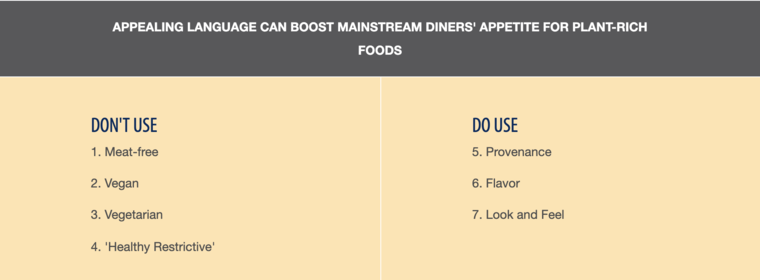
Essentially what they gathered was:
- “Meat-free” means less of what meat-eaters like
- “Vegan” means “different from me
- “Vegetarian” means “healthy — but unsatisfying — food”
- “Healthy restrictive” language such as “low fat” has low appeal
Recap
So the rising demand for plant-based has your brand in the hot seat eh? Our insights, along with other industry research suggests that you should start marketing your plant-based brand in a sexy way and have it taste just like chicken (or any other sort of meat)!
Why you need to think about DIY in product innovation
When it comes to product innovation, people have always been interested in creating and developing products themselves. If you are a brand manager who is searching for a new market trend or product opportunity, look no further. According to technavio, the value of the DIY industry is estimated to climb to 13.1 billion by 2021. This is definitely not something you can just shrug your shoulders at! You should be extremely interested in leveraging and building DIY into your business strategy and I’m going to tell you the reasons why.
Do-it-yourself (DIY): The Research
In order for us to extract the most valuable insights and perspectives, we have to ask ourselves some stimulating questions. Why do consumers participate in DIY? What kind of DIY projects are they creating and consuming? Where do people get information about DIY? Considering these questions, we were able to propose the following hypothesis:
Consumers are shifting their focus from ready-made products and alternatively, they are creating/customizing their own.
Do-it-yourself (DIY): Survey Analysis
The survey results are outstanding. We did not expect to have so many DIY advocates using our program. Here are some of the high impact results that we obtained during our research. As you are reading, please keep the following details in mind:
- Respondents are predominately females – 80%
- Millennials and Gen X account for the majority of the responses – 81%
- Approximately 40% of respondents are located inside Ontario

Almost 50% of our members indicated that DIY projects allow them to express their creativity. This is an interesting finding on two levels.
First, you can empower your customers by providing them with access to DIY resources,
Second, by embracing DIY, your customers will feel a stronger connection to your brand.

Our members are going into 2020 feeling empowered to create products on their own terms! When it comes to DIY projects, people will often use platforms such as: Google, YouTube and Pinterest in order to watch and consume instructional content for product development.
For example, the graph provided below is the number of times someone has entered the key phrase “how to” into Google search, a common phrase that indicates someones intention to complete a task independently. As a brand manager, you want to communicate with your digital team and offer “tutorial” style videos to your consumers to encourage DIY using your products. This graph reinforces that DIY is not temporary, but for the last 15 years has experienced steady increases.

Do-it-yourself (DIY): DIY Trends
We decided to consult Google trends in order to identify correlations between our findings and the general search history online. We were able to find a consistent pattern in the DIY environment.
Based on the graph below it is evident that DIY search results peak in October for five consecutive years. When we asked out members on Caddle “what time of year do you prefer to create DIY projects?” we found that 45% said summer and fall. That being said, there are definitely some promising opportunities presenting themselves during Halloween.
If you are anything like us, you want to keep digging. Ask questions like, how can we increase DIY participation in the off season? Or, how does the DIY environment change based on time of year and are there any accessibility issues that may help bridge this gap?

Do-it-yourself (DIY): The DIY Difference
So why are people all about DIY?
Not only does DIY fulfill your need for a basic product or service, but it really provides the participant with a unique and intimate product experience. The ability to work within a strong DIY community is empowering – it requires you to challenge yourself both physically and intellectually.
As we identified in our surveys, DIY allows people to express their inner creativity. If you are able to provide customers with the ability to customize their products and have a stake in the process, you can begin to capitalize on this growing industry.
Do-it-yourself (DIY): Business Opportunities
Whether you are a business looking to tap into this market or someone who is trying to build a person brand and showcase your skills online, the following information will be extremely relevant. Consider the following tips.
Have a strong social media presence
Just being online doesn’t cut it anymore, there is a lot of noise in the DIY community. The DIY business model has become reliant upon video and image based applications (Pinterest, Instagram and YouTube). In order to truly showcase the importance of social media in DIY we asked our members the following question, “where do you typically get information about DIY?”
The response was 52% of our members are using social media to get information about DIY. If you are a digital manager this is right in your wheelhouse. Take this opportunity to make your presence known by leveraging all of the available platforms and create content that is both informative and aesthetically pleasing.
Our advice to you…start building your brand on Pinterest! A whopping 32% of respondents said they get their insights from Pinterest, prior to browsing other platforms. If you are having trouble building this content from scratch, browse social media influencers to get a good idea of the do’s and don’ts.

Buying DIY
So get this, DIY supporters are creating their own products, but they also express interest in buying other peoples projects. 40% of our survey respondents indicated that they are interested in purchasing other peoples DIY offerings.
This type of purchase is far more complex and unique that than the traditional shopping experience. DIY products offer more transparency, sellers are often inspired to showcase their personality, their story and their development process. In a digital age people are basically begging to feel a personal connection between the brands they are purchasing from. Obviously they need to see value in the product, but ultimately customers will choose to connect with brands that embody their values over others.
Supporting Sustainability
There are many different reasons why people participate in DIY and evidently environmental sustainability seems to have the biggest impact. Why is this? Well, DIY advocates pride themselves on their ability to not let anything go to waste!
NBC states that that search requests for sustainability on Pinterest are up 108% since 2018! Traditional manufacturing and mass production is messy and it often leads to excess amounts of waste and environmental damage. A Neilson study indicates that 42% of North Americans are willing to pay more for companies that champion sustainability and social responsibility.
Based on our findings we don’t see this trend to becoming to a halt anytime soon. Consumers, more than ever, are advocating for more transparency amongst brands and they are willing to abandon long time loyalty for better values. Companies and D2C brands that embody this mantra will have better success with the DIY demographic. If you need more evidence of these changes, feel free to check out of blog on plastic and sustainability.
More about us
Thanks for taking the time to read our blog post. If you want to get your hands on some more data just shoot us a message, we are happy to help. If this is your first time on our webpage, you might be wondering what we do.
Caddle is a data insights company that has a passion for understanding market trends. We collect, sort and analyze data in order to provide businesses with the upper hand against their competitors. You can certainly never know too much about your consumers.
We pride ourselves on having our finger on the pulse of Canadians and our 300,000 monthly user base helps do some of the talking. What are you waiting for, let’s work together!
How to turn data into diamonds: the double diamond process
For about four years now Caddle has been creating surveys each and every day for our consumers, giving them the opportunity to earn rewards in exchange for the insights our clients need.
That’s one new survey every day for 365 days out of the year. Each survey itself has 5 questions – that’s 1,825 new questions total. Now multiply that by the amount of responses we get from each survey and my oh my, that’s a heck of a lot of data to sift through!
You may be beginning to wonder how we come up with all these surveys.
Cue the Double Diamond Process. Using this process we’re able to diverge and converge throughout multiple processes and refine a topic into priceless insights you need.
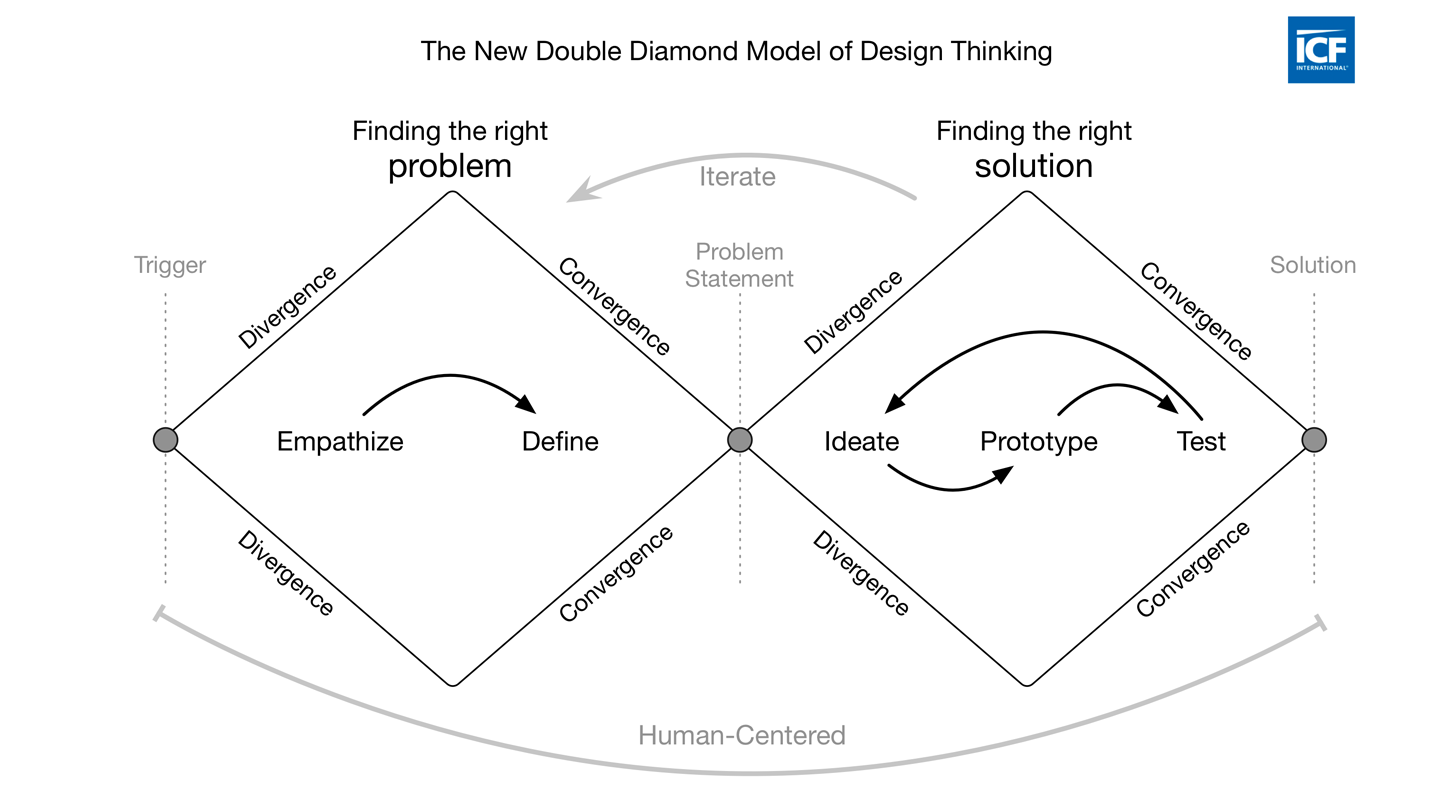
A spin-off from the divergence-convergence model proposed in 1996 by Bela Banathy, the Double Diamond Process was popularized by the British Design Council in 2005. Today, the Daily Survey team at Caddle uses the process from start to finish when creating surveys and collecting valuable insights for industries who need it.
Step 1 – Find a Trigger
By staying up to date via social listening and paying attention to the news, each month the Daily Survey team creates monthly cycles that will help frame topics that will be researched.
For the month of January, one topic we were interested in investigating was new consumer experiences.
Step 2 – Widen your lens on the world
Once we’ve selected a topic from the cycle, we diverge and take a deeper dive. We challenge ourselves to think through all areas which intersect with the trigger.
This can often feel like boiling the ocean, so in order to be efficient with our time, we use the Pomodoro method. This amazing growth hack forces focus, and helps us prioritize what’s most important. Here’s how it work
- Each team member chooses a topic to explore
- Moderator sets timer for 25 mins
- Each team member goes through four, uninterrupted 25-minute cycles of research and brainstorming to come up with topics of interest.
- Between work sprints, the moderator asks the team some open-ended questions about their work and looks to further expand thinking.
Step 3 – Daily survey creation
Once the team has curated a surplus of topics and questions, it is over to our question sorter to build out our research schedule. During this stage, questions are grouped into 5 question surveys, which provide a unique lens on a current issue.
For the new experiences cycle, DIY culture was one of the areas we focused on, as we had a hunch that DIY experiences were on the decline with consumers.
Step 4 – Find the pain
This is when the Daily Survey team breaks out their bets. The team discusses the survey questions and begins hypothesizing on what the data will answer to our questions.
Is it a dying culture? What experiences and emotions do people most associate with DIY culture? These were all questions we were going to ask and get answers to.
Step 5 – Data collection
Once the surveys have been finalized, they go live on our platform where members answer the survey and receive a cash reward in exchange for the data they’ve so graciously provided us.
The data science team then neatly compacts the data into a data mining report that can be easily used to break down the survey responses by gender, age, demographic, and any other filters we might find useful.
Step 6 – Show me the insights!
These reports are then handed off to the marketing team where they begin a charting process, highlighting the most interesting insights that tell a story about the DIY consumer experiences.
In this instance, insights suggested that DIY culture is ripe for disruption in the self-care industry.
Step 7 – We have a few more questions…
The marketing team then conducts further research on the particular industry to determine why DIY culture has the potential to disrupt the self-care industry.
These findings, in relation to the insights we gathered are then curated into marketing content that is shared on our blog for industry experts to learn more about.
Step 8 – Review our report card
We look for a couple of things when investigating success and failure. In order to identify insight paths for new products, we tend to look for 40% or more of responses aligned on interest.
When evaluating disruption in the product life cycle, we align our thinking with Growth Hacking expert, Sean Ellis, author of the bestselling “Hacking Growth”. Sean has popularized the idea of product-market fit, which has a lot of value as you decide your priorities using this funnel. Sean has often said that if at least 40% of your existing users wouldn’t be “very disappointed” if your product disappeared then you don’t yet have product-market fit.
Often there isn’t a clear solution to the insights we’ve found. But that’s okay, Caddle loves when this happens! That means that we get to probe the subject even further and continue the double-diamond process.
To delve deeper into a topic, we’ll propose new questions that we’ll ask in upcoming surveys to draw further conclusions. We’ll also reach out to the reader who may have a particular question about the insights we’ve gathered and include it in our survey research.
You can follow our double-diamond process by checking out the blog we wrote about the DIY culture and its potential to disrupt the self-care industry.
If you’d like to follow this DIY journey, make sure to keep up to date with our blog. Similarly, if you have questions about your industry that you want answered, make sure to reach out to us!
Here’s why you should be using MaxDiff in your market research
First off: what the heck is MaxDiff?
In layman’s terms, it’s the process of elimination by comparing the best and worst factors. Sound’s easy, right? That’s because it is (for us data scientists at least)! When getting into the nitty-gritty, there’s more to it. In the past, we’ve included this technique and it’s done wonders for getting the insights we need.
Comparing Apples to Oranges
Let’s say you’re planning a road trip and you can’t determine which route is the best to take for a multitude of factors:
Route A Includes: Route B Includes:
• Beautiful scenery • Familiar route
• Great food along the way • Cheaper gas stations
• Shorter travel time • Longer travel time
• Don’t have to see the in-laws • Have to see the in-laws
You’re stuck between a rock and a hard place, right? Both routes have pros and cons so how are you going to determine which is the best route to take? Hello, MaxDiff (insert superhero music)!
MaxDiff allows you to compare each element and rank them from most appealing to least appealing – which might look something like this:
Best to worst options ranked
• Don’t have to see the in-laws
• Familiar route
• Shorter travel time
• Beautiful scenery
• Cheap gas stations
• Great food along the way
• Longer travel time
• Have to see the in-laws
Based on your decision to rank the best options compared to the worst options, you might choose to go with Route A.
Great but how can I use this at work?
We’re glad you asked! Have you ever noticed that one product claim drives more sales than what it does in another part of the country? With MaxDiff you can test which one claim will drive the best sales for both of your consumers. This helps you get better insights from consumers because they need to actually rank what’s most important and what’s not.
You see, whether it be packaging, pricing, or claims testing, getting that call to action can be difficult. If you’re unsure of which call to action is best for your product, we encourage you to give MaxDiff a shot. You can inquire here!
Growing DIY culture suggests big opportunity for beauty trends
The act of making time for yourself using varied techniques to take care of your mental and physical wellbeing has become a major opportunity for brands. And a rather expensive one to say the least.
From skin care products to yoga memberships, these self-care healthy lifestyles quickly add up over time. But are these beauty and wellbeing trends worth it?
Due to the expensive nature of self-care, DIY culture has been on the rise. DIY culture is defined as the process of doing things yourself for a fraction of the cost, and has begun disrupting the industry.
When comparing DIY searches under the health category, the Google Trend results speak for themselves.
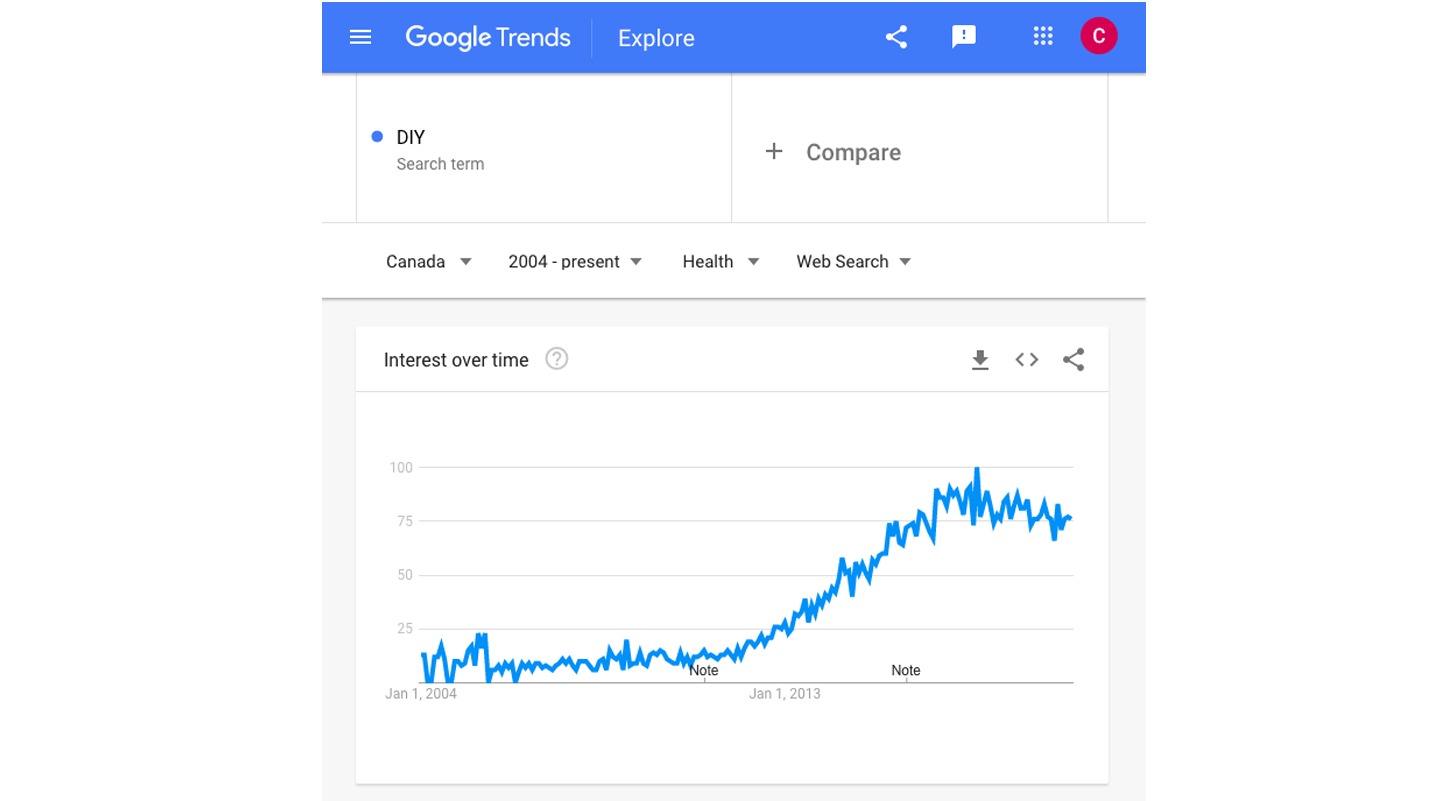
DIY for better wellbeing
In search of further insights, our team of data scientists tested this hypothesis to see if the self-care industry was ripe for disruption. In a survey with just over 9,800 responses, 39% of survey respondents agreed that they feel the self-care industry will be impacted by DIY culture.
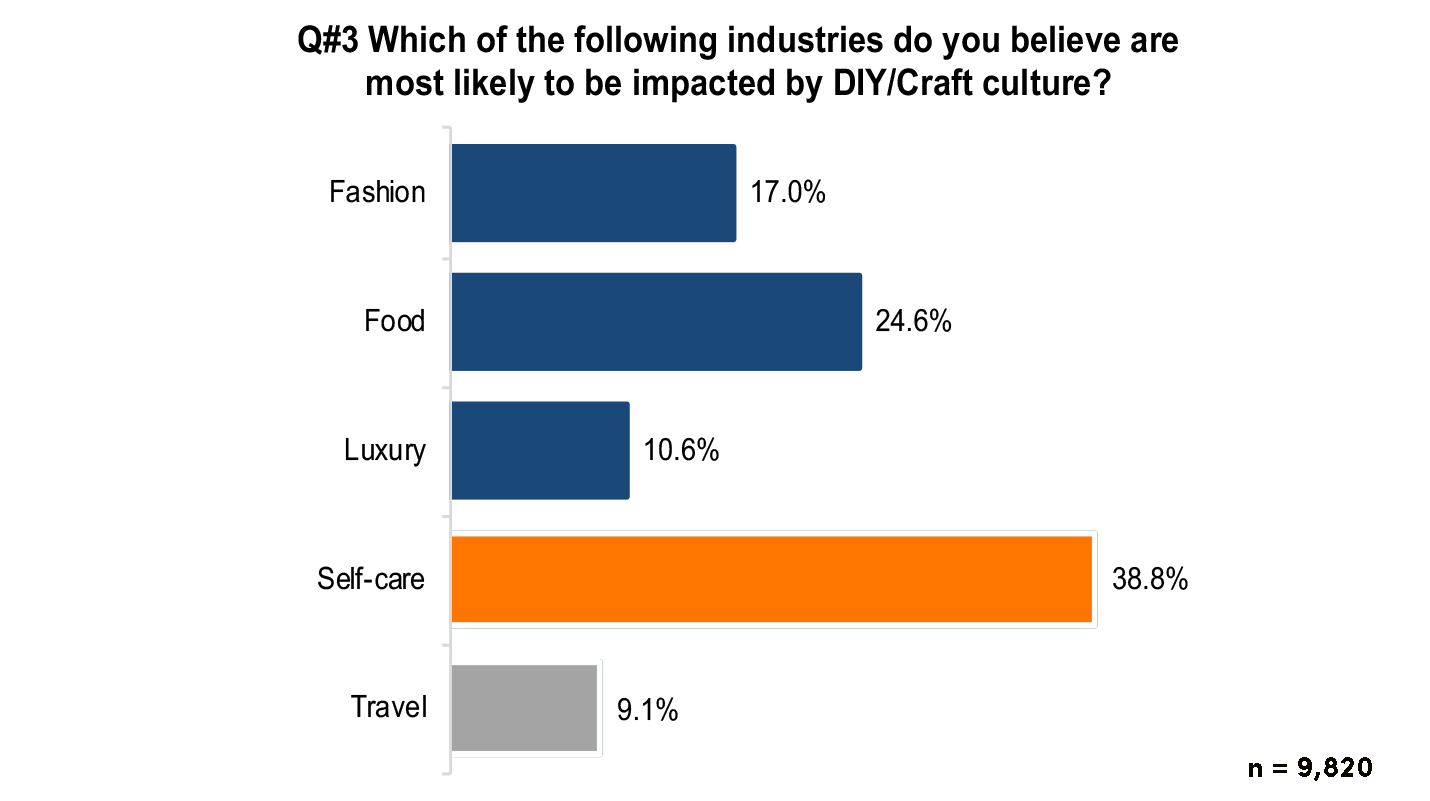
Younger generations most likely to disrupt the industry
Millennial and Gen Z females aren’t too keen on spending money when it comes to their self-care. These generations over-indexed in agreeing that DIY culture will impact the self-care industry.
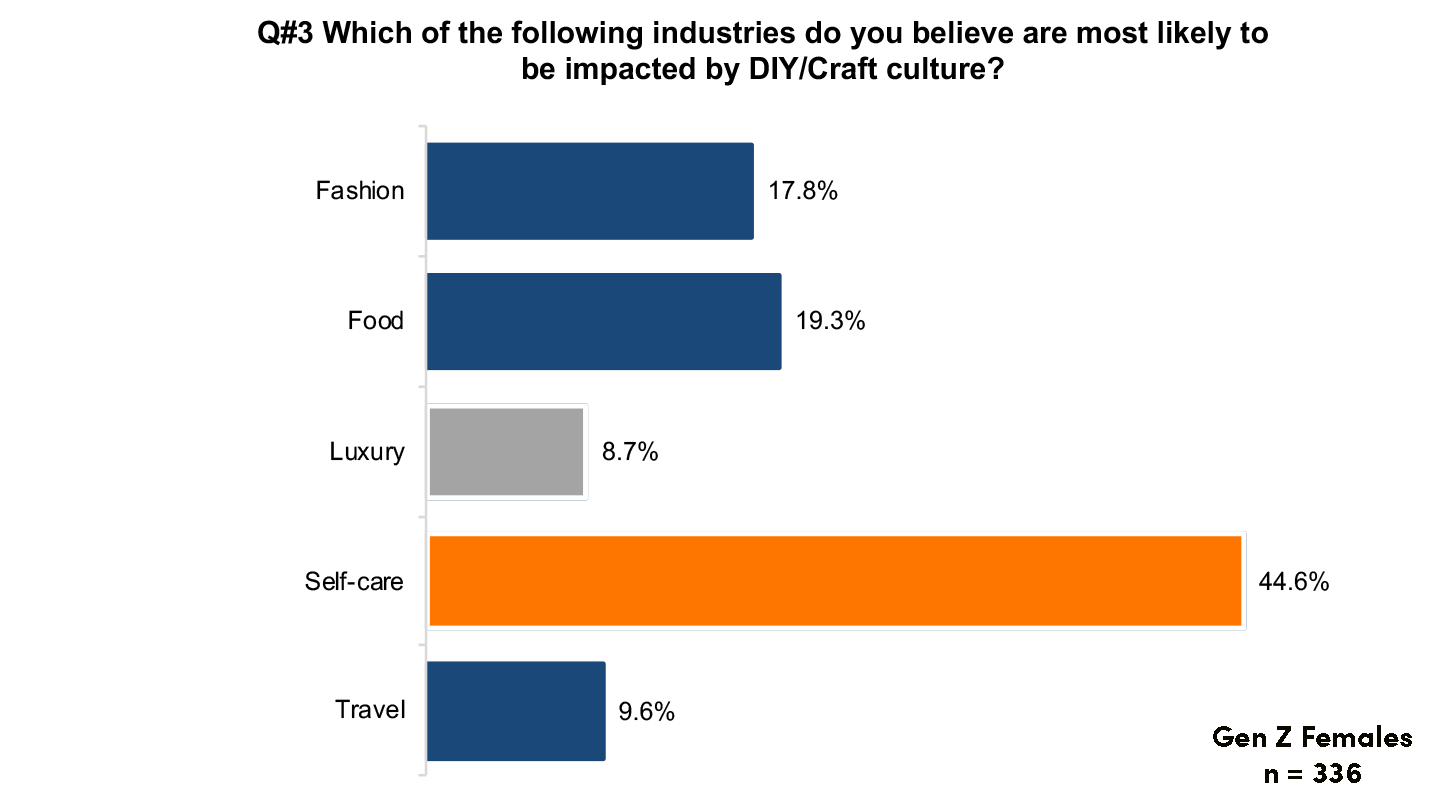
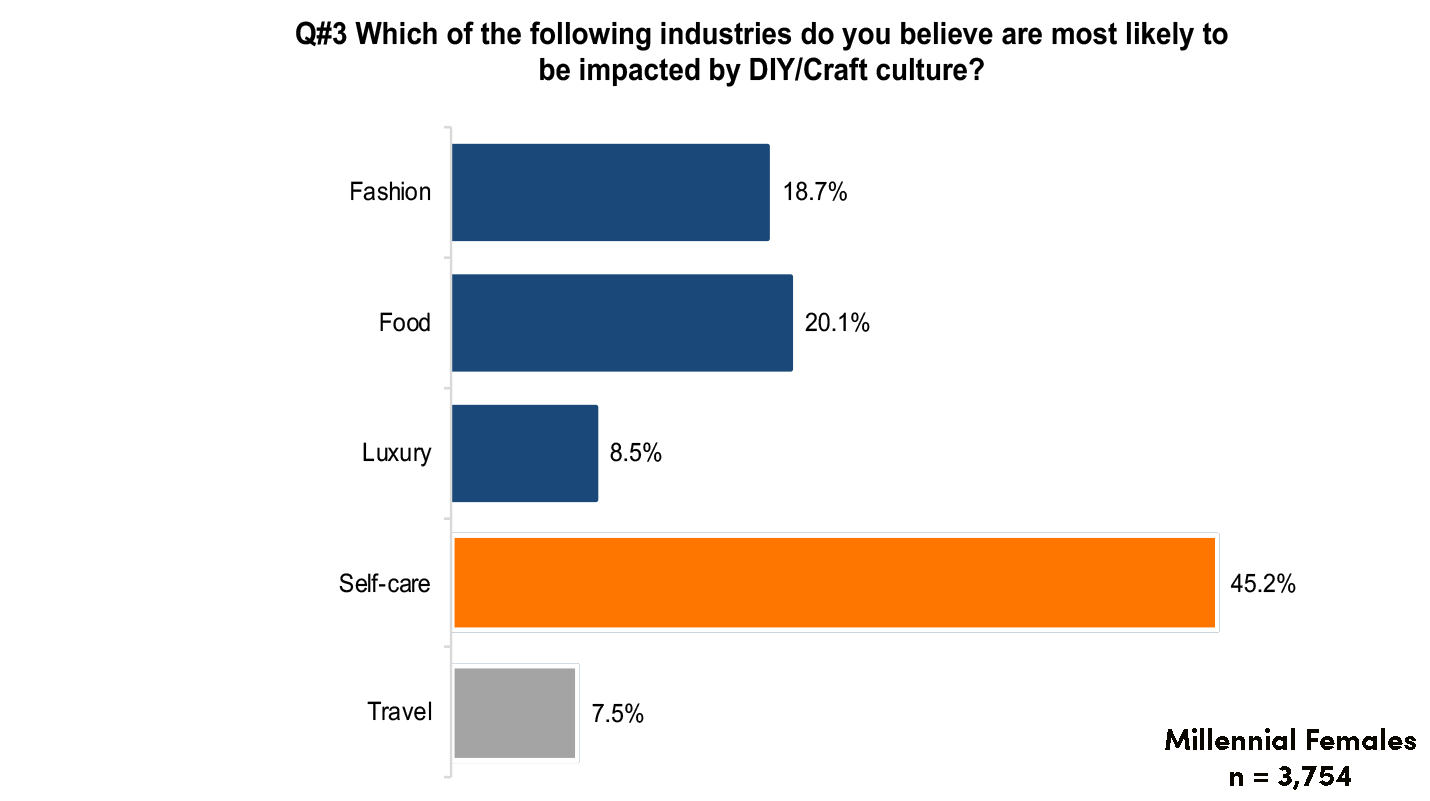
East is the best test market for your new self-care DIY product
Out of all survey results, Millennial females living in Nova Scotia seem to pose the biggest opportunity to the self-care industry.
There may be no better place to develop some self-care DIY products than Nova Scotia. Hardened by brutal winters, peaceful surroundings, and often stormy waters, the millennial females of Nova Scotia seem to be always on the lookout for new ways to treat themselves to some self-care. Perhaps this DIY culture in itself is self-care.
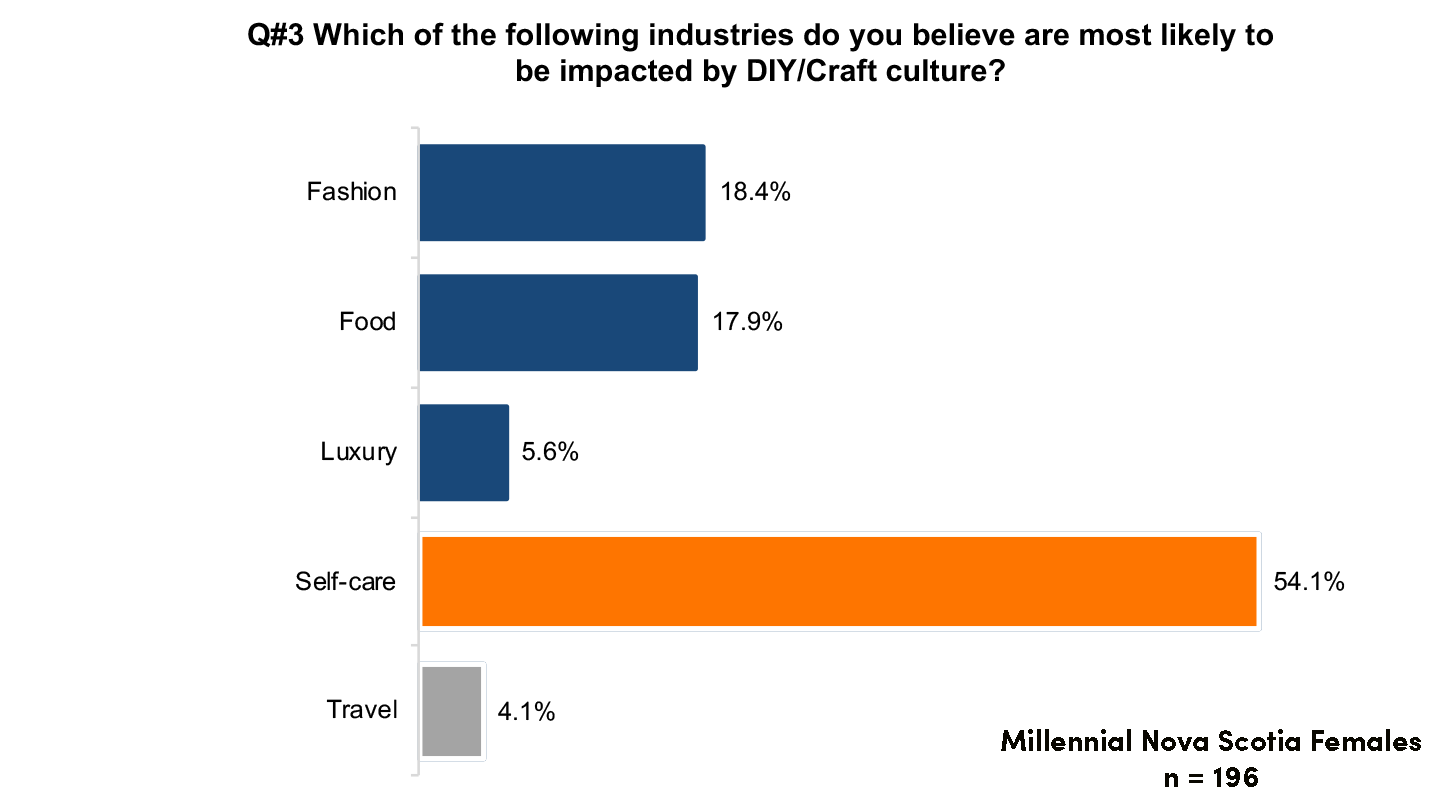
How can you jump on this opportunity?
While self-care encompasses both the physical and mental wellbeing, a quick search on the interwebs seems to indicate that the skin-care segment is most at risk due to the pricey nature of these products. Both Google, YouTube and Pinterest highlight frugal ways to make DIY skin-care products for a fraction of the cost.
In a positive light, these ‘risks’ can actually be seen as opportunities. Further insights we collect from our rapid research through crowdsourced surveys, we can help pinpoint exact consumer pain points which industry leaders can target.
Opportunities most ideal for beauty brands
Frankly there just isn’t enough insight to suggest where disruption is most likely to target in the self-care industry. But it might be beneficial to create a product line that tends to the frugal shopper for starters.
A recent report by CB Insights found that traditional self-care brands might want to invest in indie brands and innovative technology.
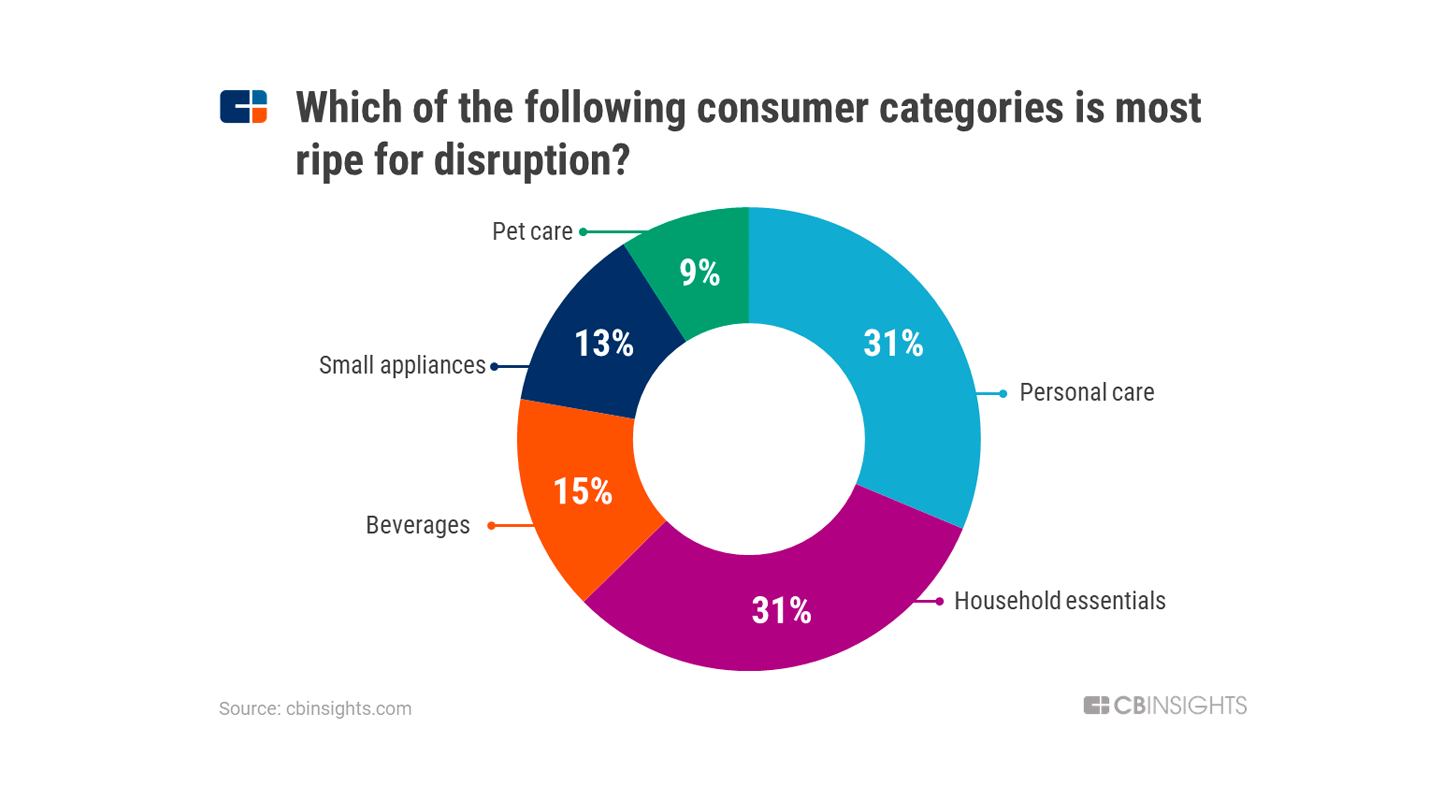
What’s in store for 2020
Despite what the factors may be, 2020 has the opportunity to disrupt many industries and create a whole new area of opportunity. Some trends you might expect to see throughout the year could be:
- More incubator projects from Fortune 500 companies like P&G, J&J and L’Oréal,
- More packaged DIY projects,
- Increased alignment with social responsibility and environmentally friendly customer experiences
Got questions? We’ve got answers
- All these insights making you thirst for data? Request the full report here
- Got a question for our DIY panel? Submit your question and you might be featured in our next blog
- Looking to learn more about Caddle’s capabilities? Click here
Caddle Answers: What if my receipt isn’t approved before the offer expires?
Did you upload the receipt before the offer expired, within the correct time frame? Then you’re all good!
Even if we don’t get the chance to process your receipt until after the offer has expired, as long as you’ve uploaded your receipt before the offer expires, we’ve got you locked in! You’ve successfully reserved your spot to earn the reward.
Delays do not mean that your receipt is suddenly going to be outside of the time frame for the submission you made on time – that would just be plain rude of us to do that!
Got more questions about how we run things at Caddle?
Great! We love answering your questions. To look for more answers to other questions, you can refer to our FAQ page or take a look through this blog page for more in-depth explanations on how we roll here at Caddle.
Still can’t find what you’re looking for? You can contact us and we’ll get back to you with the answer!
Caddle Answers: How to upload a receipt to the app
Ready to upload your receipt to cash in on some awesome rewards? This is how you do it!
There are two ways you can upload a receipt to our platform:
1. Through the app
2. Through the website
This article will explain how to upload a receipt through the app. If you’re looking at how to upload through our website, you can find that here.
Step 1:
Open the app and tap the camera icon on the bottom of your screen.

Step 2:
Select your preferred upload method. “From Camera Roll” allows you to upload pictures you’ve taken on your device. “Take New Photo” allows you to use our in-app camera. If you’re not sure which option is best, you can find out how to take the best picture for receipt approval here.

Step 3:
Once you’ve uploaded your receipts, select the offers you’re uploading for and its quantity. Once you’ve done that, tap upload.

Got more questions about how we run things at Caddle?
Great! We love answering your questions. To look for more answers to other questions, you can refer to our FAQ page or take a look through this blog page for more in-depth explanations on how we roll here at Caddle.
Still can’t find what you’re looking for? You can contact us and we’ll get back to you with the answer!
What happens when the app crashes?
You’re sitting at home relaxing, then you remember about today’s Daily Survey. You open the app and it crashes!
“Hmm, okay, I’ll just reopen it,” you think to yourself but the same thing happens again, and again.
What the heck is going on? You want that reward for answering the survey but this task is proving to be easier said than done. What do you do?
Look no further – in this blog we’re going to share with you exactly what you need to do if the app crashes. *Pro Tip* – this is a great troubleshooting step for almost all the apps out there!
Option 1: “Did you try turning it off and on again?”
Perhaps the most annoying question someone can ask you when you’re trying to troubleshoot something. But odds are, sometimes the simplest action is the one that fixes it! In the case of the app crashing, this tends to be the case as well.
In the catastrophic event that the app crashes, we suggest deleting and reinstalling the app.
Sometimes the app stores don’t auto-update the app for you and you may be using an older version of the app which has been prone to crashing. By reinstalling the app, you’re ensuring that you have the latest version of the app.
Option 2: I’ve reinstalled the app and it’s still crashing!
Now that is frustrating! We might have hit an incompatibility issue – take a quick look at the Google Play Store or App Store to see if the newest version is compatible with your device. While we wish that our app could work on all devices, old and new alike, our app has to update alongside Android and iOS updates, and that means that older devices slowly become less compatible with our platform, and unfortunately, we can’t fix the issues that might pop up as time goes by.
Here is where you can find the compatibility in each app store:
iOS users: Go to the app store and search “Caddle”. Once you’ve opened the Caddle page on the app store, scroll down to the “Information” section. There you will find the compatibility required. For iPhone, iPad and iPod users, our app requires devices running on iOS 10.0 or later. Please keep in mind that with every update from Apple, and every update from Caddle, an older device will become less compatible with our app.
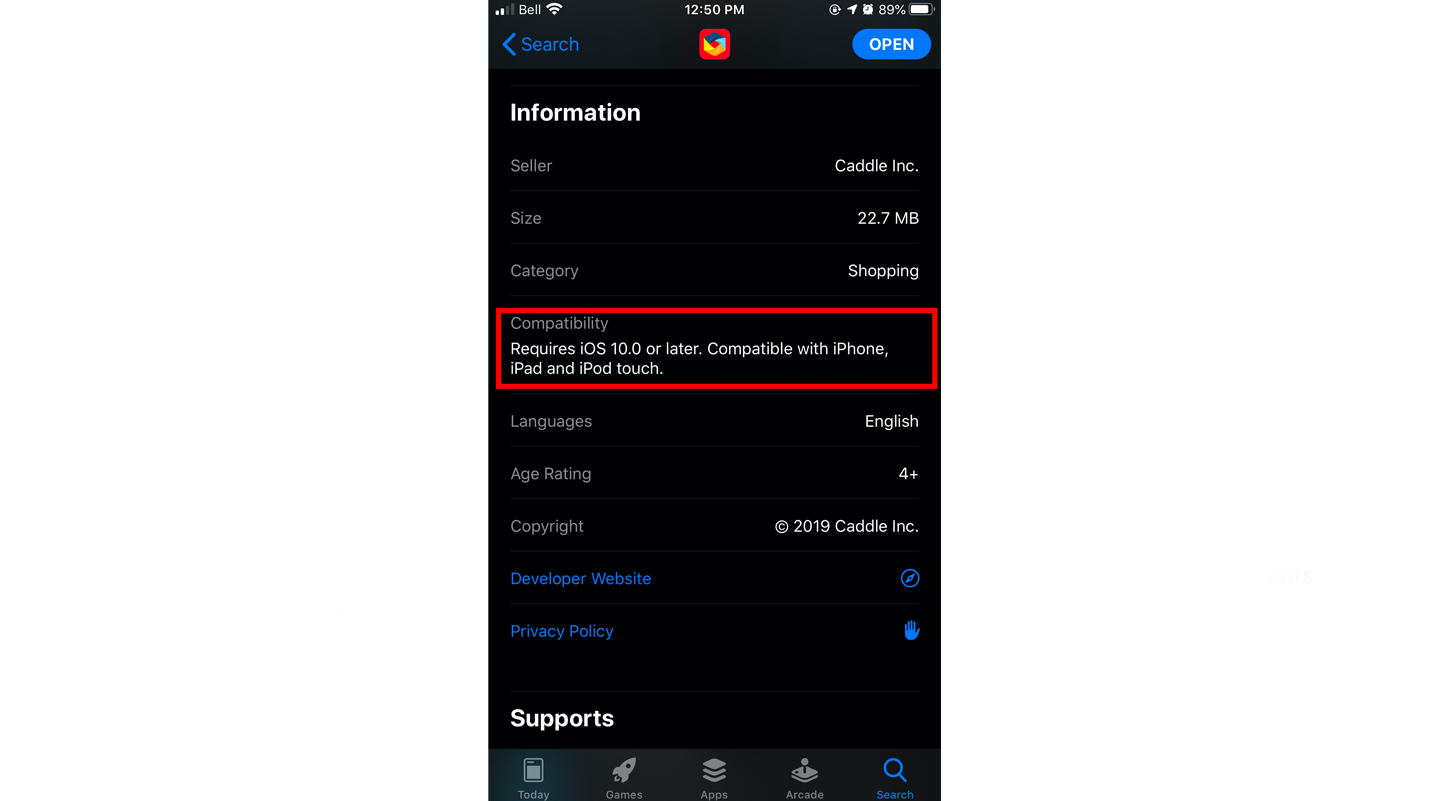
Android Users: If you can’t find the app in the Google Play store on your device, it is likely that the app isn’t compatible. To see what device requirements are needed, you can use your computer and search for the Caddle app in the Google Play store. Once you’ve found the app in the Google Play store, scroll down to the bottom of the page and look for the “Additional Information” section. The “Requires Android” information will tell you what device is required to use the Caddle app.
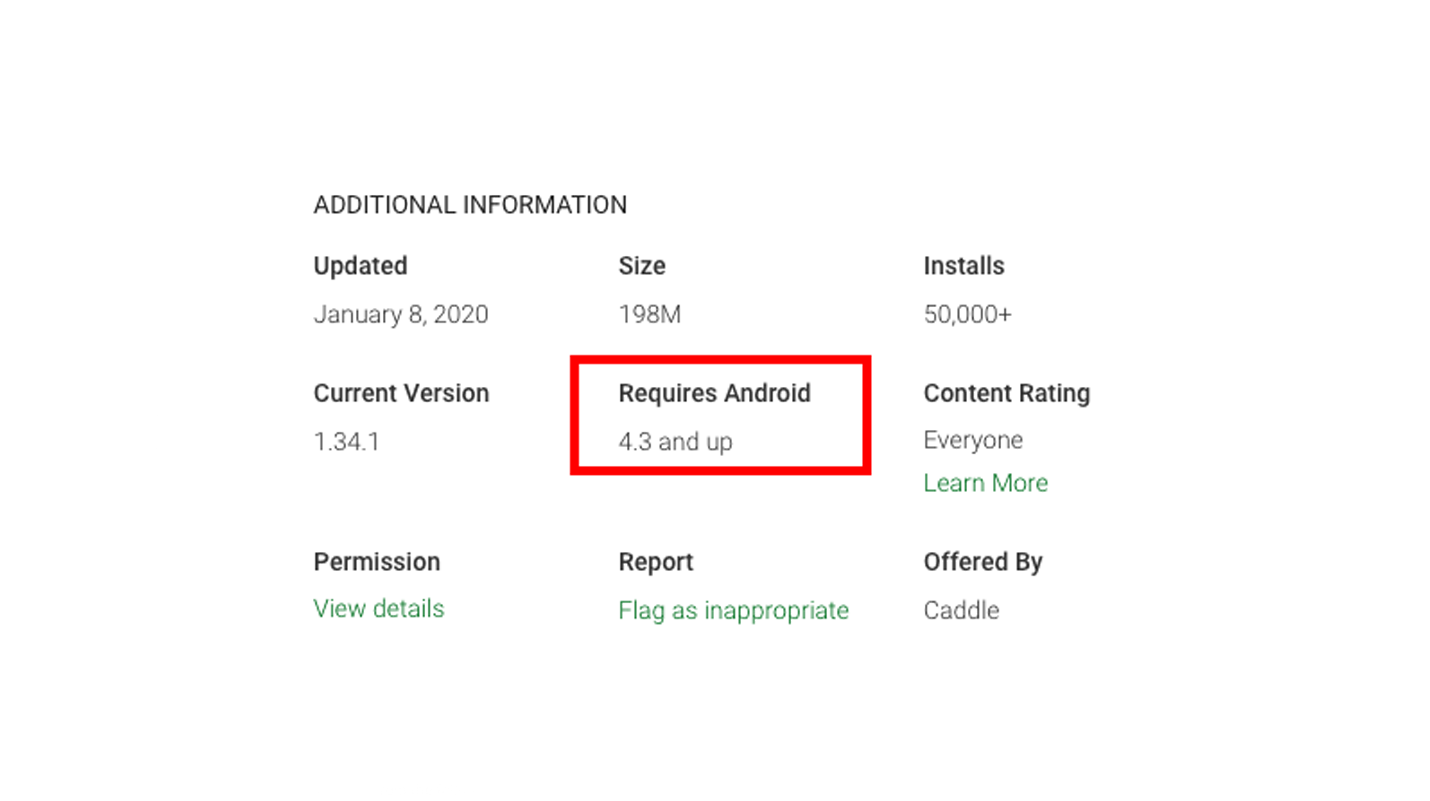
Option 3: I’ve got the newest device on the market and the app is still crashing
You’ve got the newest of the new device, the app is up-to-date, and you still can’t give your opinion on DIY Culture. Now what?
Odds are if everything is good on your end, you’re likely not alone and this is a widespread issue. In this case, we’re already aware of the situation and are working hard at resolving it.
In the meantime, if you’re looking to upload receipts you can always hop onto our website and upload them to our offers that way! This will ensure that you won’t miss out on those offers and that means getcaddle.com has saved the day! Not sure how to do that? Read all about it here.
Got more questions about how we run things at Caddle?
Great! We love answering your questions. To look for more answers to other questions, you can refer to our FAQ page or take a look through this blog page for more in-depth explanations on how we roll here at Caddle.
Still can’t find what you’re looking for? You can contact us and we’ll get back to you with the answer!
Caddle Answers: How to upload a receipt to the Caddle website
Did you know that you can upload your receipts to claim offers on our websites as well?
Here is how you do it!
Step 1:
Go to getcaddle.com/consumers/ and sign in to your Caddle account.
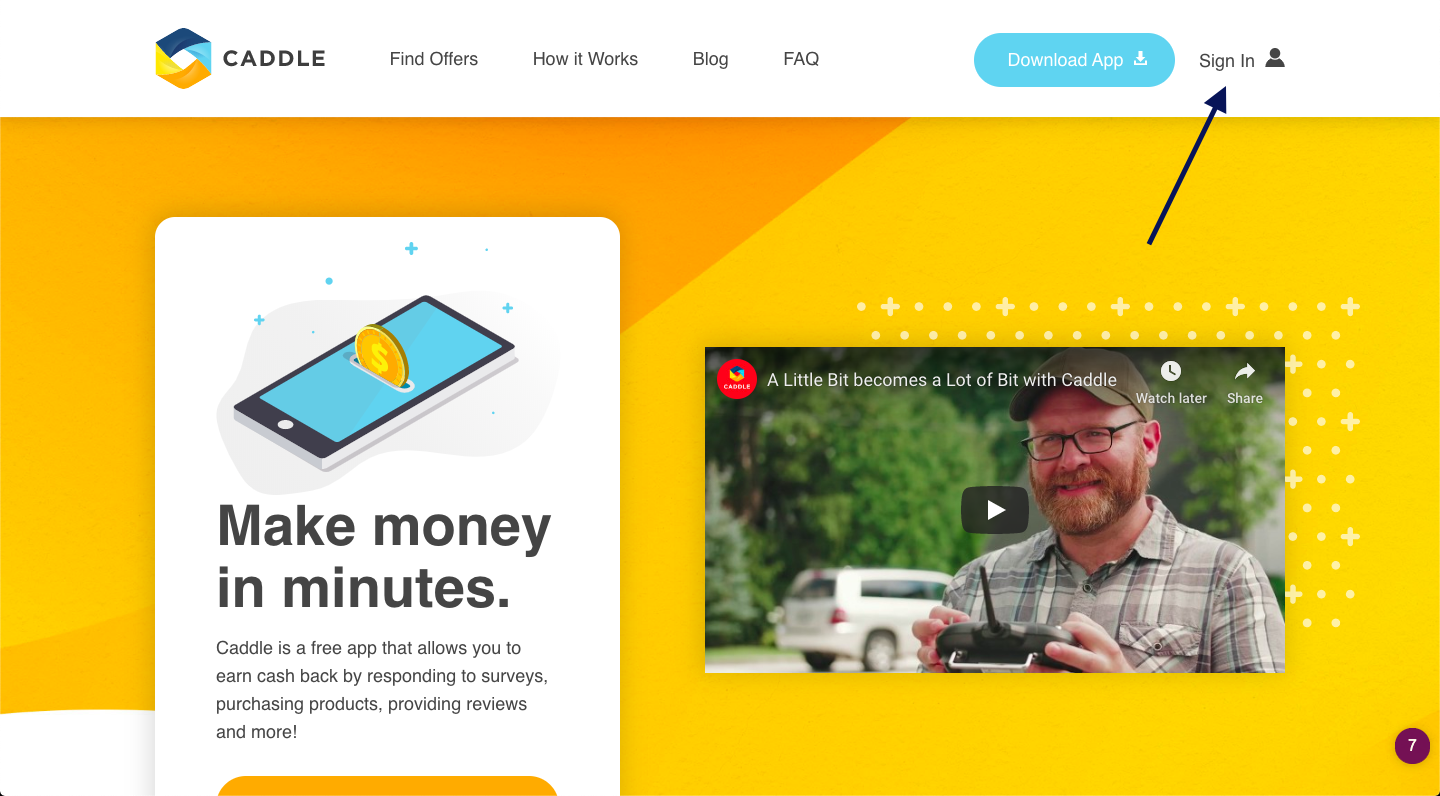
Step 2:
After you’ve signed in, find the “Upload Receipt” tab on the top and click on it.
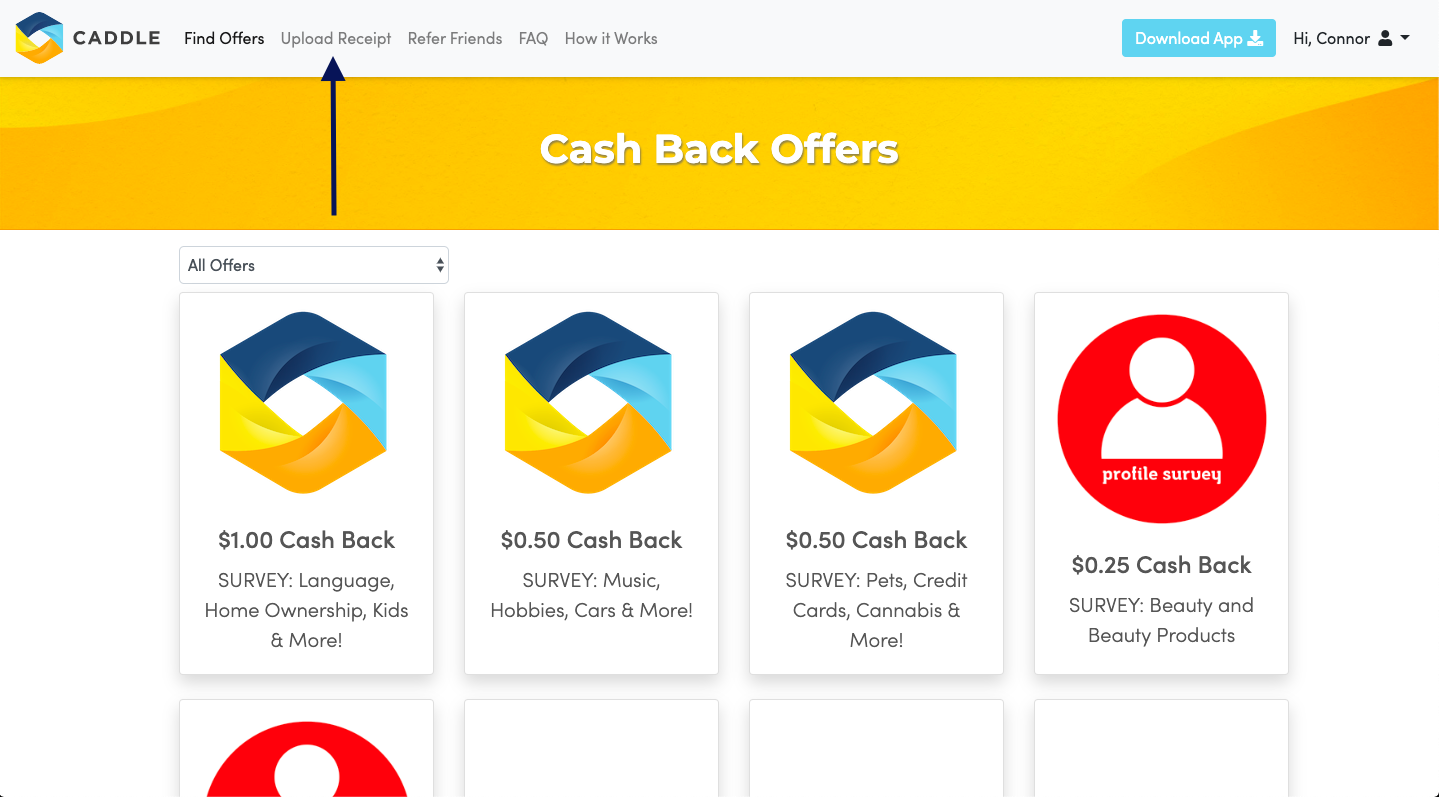
Step 3:
Upload your receipt images and select the appropriate offer. This page tells you exactly how to do it in two easy steps!
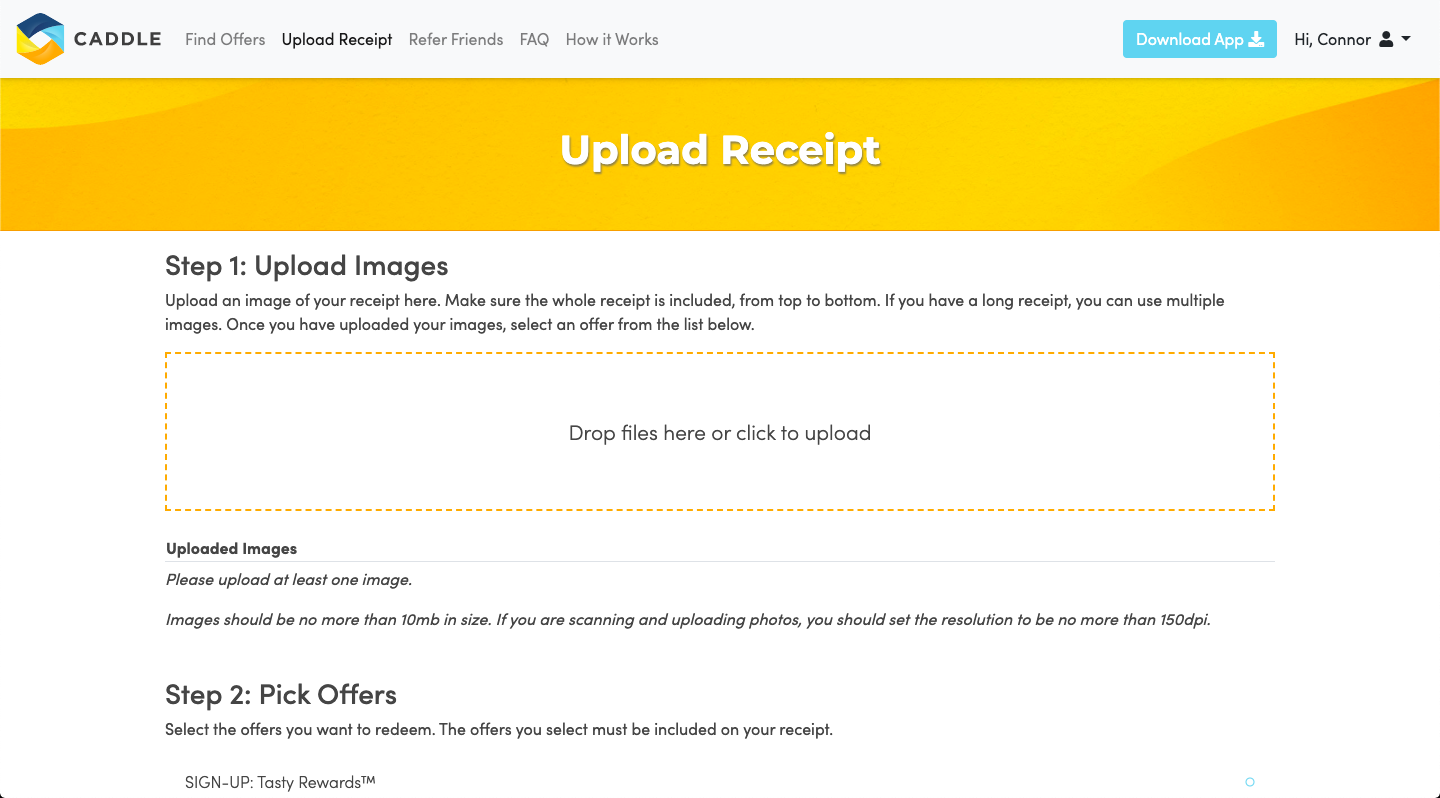
Got more questions about how we run things at Caddle?
Great! We love answering your questions. To look for more answers to other questions, you can refer to our FAQ page or take a look through this blog page for more in-depth explanations on how we roll here at Caddle.
Still can’t find what you’re looking for? You can contact us and we’ll get back to you with the answer!
